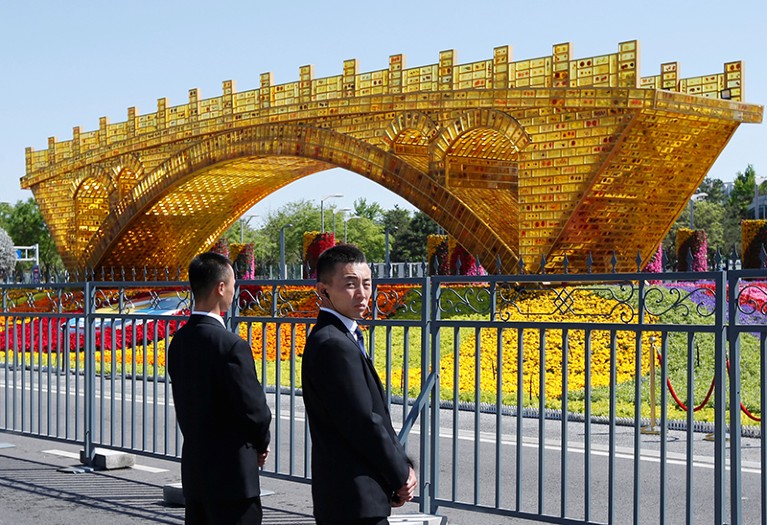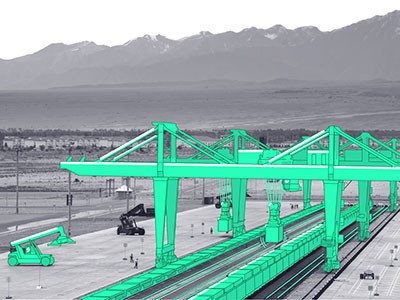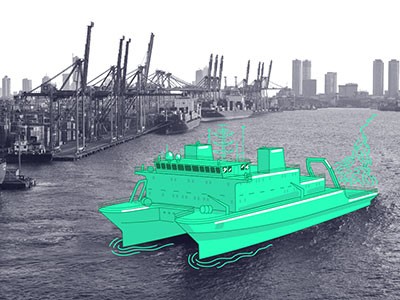
Security personnel near a ‘Golden Bridge on Silk Road’ decoration for the Belt and Road Forum in Beijing in April.Credit: Jasin Lee/Reuters
Takht-i-Bahi, or ‘Throne of Origins’, is a 2,000-year-old Buddhist monastery complex in an unexpected place — a hilltop in the north of predominantly Islamic Pakistan. But it hails from a time when this region helped to spread Buddhism into China. Centuries ago, the area was on one of the ‘silk roads’ that connected China to western nations as far away as Europe. These were the Internet of the ancient world, linking people from distant regions and transmitting art, culture, religions, science and goods.
Today, however, the traffic is mostly one-way. One hundred metres below the monastery is a motorway so new that animals still outnumber cars on its fresh tarmac. The motorway is a small part of a huge network of roads, railway lines, and air and sea ports ready to transport goods to the 126 countries with which China has signed cooperation agreements in what it is calling the Belt and Road Initiative (BRI).
The BRI is the single largest project to build infrastructure worldwide since the Marshall Plan to rebuild Europe after the Second World War. Even conservative estimates suggest that the total cost will run to around US$1 trillion.
How China is redrawing the map of world science
Trade is the central focus of the BRI, but China’s leaders say that science is also an important element. So a team of reporters for Nature took to the road to examine how the initiative is shaping the lives and work of researchers on four continents targeted by the BRI. Over the past six months, they have interviewed more than 100 researchers, graduate students, policymakers and government-watchdog organizations to chart both the promise and the potential problems of China’s activities. We are publishing their reporting in a series of five articles over the next two weeks.
China’s influence on science is widespread, ranging from infrastructure to research programmes to people. In the space of six years, the Chinese Academy of Sciences (CAS) — probably the largest contributor to BRI science — has provided almost $268 million for projects that include setting up five research facilities in Beijing and nine research centres in other countries. Much of China’s investment is going on master’s and PhD scholarships. In Pakistan alone, some 7,000 students are funded each year, a figure that is set to increase to 20,000 from next year.
Contrasting views
The positive view of China that these investments are creating among many scientists stands in stark contrast to the suspicion that pervades the way in which governments of Western nations, India and Japan approach the BRI. And the support from China is heralding a generational change, too. In the collaborating South Asian countries especially, many older, English-speaking scientific leaders with PhDs from Europe and the United States are retiring. Many of their successors will have been trained in China, and that is where they will look for future contacts, collaborations and support.
Scientists in Pakistan and Sri Lanka bet their futures on China
But China is not giving away its money for free. In many cases, the infrastructure projects involve huge loans by Chinese banks that some low-income countries are struggling to pay back. This has resulted in Chinese companies taking control of key national assets, such as the ports of Piraeus in Greece and Hambantota in Sri Lanka.
All aid in science ultimately comes with health warnings, and China’s largesse is no exception. Our reporting highlighted three concerns that China and its partner nations need to consider.
First is the close involvement of commercial enterprise in BRI science projects. In many cases, there is a requirement that buildings — and sometimes equipment — must be delivered by companies from China. China’s leaders call this ‘win–win’, an explicit understanding that its aid comes with strings attached. But this is problematic, because specifying that work be undertaken by particular firms using certain technologies could influence or compromise research.
Risk assessment
A second concern is the way in which, in many countries, Belt and Road projects — such as new roads and dams — are proceeding without a rigorous assessment of environmental risks or the impact on local residents. In Pakistan’s universities, for example, research into the health and ecological impacts of the BRI is almost nonexistent. This is because the government and military do not want to embarrass China should the conclusions be anything other than an endorsement of BRI projects.
Fortunately, China’s leadership is starting to acknowledge the initiative’s environmental risks. Last week, the government hosted the first ever green BRI forum to examine how to mitigate the project’s environmental impacts. But these efforts could quickly descend into ‘greenwashing’ unless there is active follow-up from President Xi Jinping or other Chinese leaders.
A third concern is the lack of transparency — and mixed signals — about the BRI. On the positive side, CAS helped Nature to visit joint research sites in Sri Lanka, and set up meetings with personnel in China. But when our reporters have requested interviews with the leadership of CAS, there has been no response. The Chinese government has not even published a definitive list of BRI projects; publicly accessible contracts are rare; and there are no agreed estimates of the scale of funding.
Public accountability on all sides is essential as China becomes more deeply involved in the affairs of other nations. The BRI has the potential to shape research in the global south and accelerate the generation of knowledge in ways that could benefit many countries — but the overall approach has to be in keeping with the best of Chinese and global values.
More transparency, more public engagement, fewer conflicts of interest and a shared understanding of the scientific and environmental challenges along the road will ensure that the traffic in ideas flows in two directions, as it did along the original silk roads.

 How China is redrawing the map of world science
How China is redrawing the map of world science
 Scientists in Pakistan and Sri Lanka bet their futures on China
Scientists in Pakistan and Sri Lanka bet their futures on China
 China charts a path into European science
China charts a path into European science
 South America is embracing Beijing’s science silk road
South America is embracing Beijing’s science silk road
 Chinese investments fuel growth in African science
Chinese investments fuel growth in African science
 Steps to the digital Silk Road
Steps to the digital Silk Road
 Environmental challenges for the belt and road initiative
Environmental challenges for the belt and road initiative






